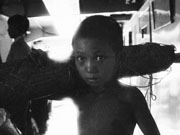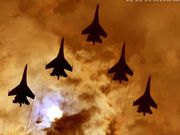WASHINGTON, Dec. 5 -- NASA's new human spacecraft, Orion, completed a "nearly flawless" first test flight on Friday in what the space agency hoped to open up a new era in American space exploration.
"Today's flight test of Orion is a huge step for NASA and a really critical part of our work to pioneer deep space on our journey to Mars," NASA Administrator Charles Bolden said in a statement. "The teams did a tremendous job putting Orion through its paces in the real environment it will endure as we push the boundary of human exploration in the coming years."
The uncrewed spacecraft blazed into the morning sky at 7:05 a.m. EST (1205 GMT), lifting off from Cape Canaveral Air Force Station in Florida on a United Launch Alliance Delta IV Heavy rocket, currently the most powerful in America.
Its crew module splashed down about four and a half hours later in the Pacific Ocean, about 600 miles (966 kilometers) off the coast of Baja California, where NASA and U.S. Navy teams are now in the process of recovering it for future use.
The 370-million-U.S.-dollar launch was originally scheduled for Thursday, but was delayed by a trio of problems, including a stray boat in the launch zone, strong winds and technical issues.
Describing Friday's journey as "nearly flawless," Mark Geyer, NASA's Orion program manager, told a post-flight press conference live on NASA TV: "It's hard to have a better day than today. There is a lot of fun. Very exciting."
During the test, Orion traveled twice through the Earth's Van Allen belt where it experienced high periods of radiation, and reached an altitude of 3,600 miles (5,800 km), 15 times farther than the International Space Station.
"A human-rated system hasn't gone that far" since the last Apollo moon mission came back to Earth in 1972, Geyer said. "That reminded us here we are again now -- the United States leading exploration out into the solar system."
Orion also hit speeds of 20,000 mph (32,000 kph) and weathered temperatures near 4,000 degrees Fahrenheit (2,200 degrees Celsius) as it re-entered Earth's atmosphere. Those temperatures are about 80 percent as hot as Orion would experience returning from lunar orbit, NASA said.
The test flight also validated systems such as Orion's parachutes, avionics and attitude control, and demonstrated major separation events such as the launch abort system jettison and the service module fairing separation.
On future missions, Orion will launch on NASA's new heavy-lift rocket, the Space Launch System, which is still under development.
"We really pushed Orion as much as we could to give us real data that we can use to improve Orion's design going forward," said Geyer.
Orion was reminiscent of the Apollo capsules in its shape and design, but it is larger in size and more advanced in design. It was built to support a crew of four for up to 21 days in space, but could also house a smaller crew for a longer period.
The flight also meant that NASA is now one step closer to regaining its capability to launch astronauts into space, which it lost since the end of the space shuttle program in 2011. Since then, the agency has had to rely on Russia's Soyuz spacecraft to transport U.S. astronauts to the International Space Station.
Another unmanned test flight is planned for 2018, and Orion's first crewed mission is scheduled for 2021 but there are no confirmed flights after that.
It is worth noting that although Orion is a NASA program, the test flight is managed and led by Lockheed Martin, the manufacturer of the spacecraft. NASA also said that more than 1, 000 companies across the United States manufactured or contributed elements to the spacecraft.
"Orion's test was about 4.5 hrs (hours)," Lockheed Martin tweeted. "But what we learn could change history forever."
 |

 My darling in military academy, you are the most beautiful one
My darling in military academy, you are the most beautiful one Students trained to become Miss Etiquettes in E China
Students trained to become Miss Etiquettes in E China Through a 20-year lens: Relocated three gorges residents then and now
Through a 20-year lens: Relocated three gorges residents then and now The birth of long tracks for high speed railway
The birth of long tracks for high speed railway Steel wire netting human model up high above Geneva river
Steel wire netting human model up high above Geneva river Eye-catching contestants in International beach bodybuilding competition
Eye-catching contestants in International beach bodybuilding competition 2014 Victoria's Secret Fashion Show
2014 Victoria's Secret Fashion Show Who is the most beautiful one? University and College etiquette teams in Sichuan
Who is the most beautiful one? University and College etiquette teams in Sichuan Excellent photos of Zhuhai Air Show
Excellent photos of Zhuhai Air Show Hot girls draw crowds at motor show in SW China
Hot girls draw crowds at motor show in SW China
Day|Week|Month